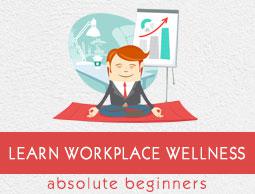Workplace Wellness - Quick Guide
Workplace Wellness - Introduction
Employers in general find healthcare solutions costly. These costs add up to their operating cost, and there is no guarantee of a full-proof solution, despite all the consumer-driven wellness programs available. However, recent innovative healthcare solutions are effective in putting a brake on the spiraling healthcare costs.
Recent healthcare solutions to the employees are a tool to address the rise of chronic diseases like diabetes and obesity that affect the productivity of an organization in a big way. In experts’ opinion, 82% of the diseases are lifestyle based and a properly designed Workplace Health Wellness Program can have a positive impact on these diseases.

Wellness programs benefit the organization in terms of reducing illness, accidents, medical claims, while curbing absenteeism because of health-related issues. Such programs eventually result in increased overall productivity. In this tutorial, we will have a close look at the steps that employees can take to improve their health in the workplace.
The Cost of Unhealthy Employees
Studies suggest that the health claims in any catastrophic event, such as heart attack or brain stroke, constitute only 20% of the total medical expenses, in comparison to a staggering 80% of the medical expenses drawn towards addressing chronic diseases like cardiovascular disease, diabetes, asthma, etc.
Barely 20% of the employees are affected by what are normally perceived as lethal medical conditions prevalent in the lives of working professionals, in contrast to nearly 70-80% who are affected by some kind of chronic disease as mentioned above. However, it is also seen that many of these chronic conditions can be prevented through successful implementation of a welldesigned wellness program.
Reports reveal that the Return on Investment (RoI) for companies that adopt any kind of healthcare solutions are in the ratio of 5:1. It means that for every five employees they provide healthcare for, only 1 remains fully fit at any given time of the year. This is a huge expense, even for well-established organizations.
Factors behind Chronic Diseases
A chronic disease may be defined as, "an ongoing and incurable illness or condition that includes heart disease, asthma, cancer, and diabetes." Experts suggest that there are three lifestyle factors that are the major contributors to chronic diseases at workplace. In this chapter, we will discuss these three factors in detail.
Obesity

Obesity is one of the major causes for a host of chronic diseases like heart diseases, diabetes, injuries, etc. Apart from the medical expenses, it also results in reduced productivity due to frequent visits to a physician’s office.
A survey done by Cigna in 2013 revealed that the most alarming situation in organizations is the exponential increase of obesity during 1993-2012. It also indicated that there is a whopping 3300% rise in the short-term disability due to obesity.
Another publisher “The American Journal of Health Promotion” found that an employer of America pays an average $8067 per employee every year towards obesity-related disabilities, as against a mere 50% cost in case of a normal weight employee.
The situation is going to worsen as the number of the obese employees are on the rise, and surveys suggest the percentage of obese people has increased from 22.9% during 1988-1994 to 34.9% in 2011-2012.
Smoking

In spite of the recent fall in the numbers of smokers, smoking still affects the economy of organizations, both in terms of cost and the lost work days. A study by the Journal of Occupational and Environmental Medicine (JOEM) reveals that a smoker who consumes more than a pack of cigarettes daily is likely to affect production adversely by more than 75%, in comparison to a non-smoker.
Globally, employers are paying nearly $193 billion every year towards the medical costs and lost productions, which brings it down to an average of $5816 per annum per smoker.
Estimates suggest that various medical related compensation costs towards the smoking employees is at $2189, as opposed to $176 for non-smokers. It is because the healthcare package cost for a smoker attracts more premium than the non-smokers. Apart from the above, the probability of a work place accident is almost twice in case of a smoking employee. Many workplace accidental fires have occurred due to such smoking-related incidents.
Stress

Stress is probably the number one factor that affects employers the most in today’s world. As reported by the American Institute of Stress, a staggering $300 billion annually is the toll that the employers have to bear for various reasons such as lost productivity, absenteeism, accidents, low employee turnover and medical costs etc. arising out of excess stress among employees.
The amount of studies that have been done on this topic far surpass any other health-related study. A study by the JOEM suggests that stress alone costs more than all other lifestyle diseases put together. It also found that the healthcare cost of a stressed employee is 46%, while that of a depressed employee is almost 70% more than an employee who has not been reported under any stress in the workplace. This qualifies Workplace Stress as a chronic disease that accounts for almost 75% of the health spending, and is the worst culprit for health related issues being on the rise.
Impact of Chronic Diseases on Economy
Chronic diseases wreck the economy in two ways. First, there is the huge expenditure that organizations have to do on the health of their working resources. Second, because of the absenteeism of the employees due to illness, there is a severe drop in the productivity of an organization, which results in missing deadlines and losing on crucial strategic advantages. The numbers themselves are staggering −
Almost 14 million workdays are lost in a year due to diabetes alone, as each diabetic loses nearly 8 days per year.
More than $160 billion of productivity lost during the year 2009 in the form of absentees and deaths due to cardiovascular diseases in America.
A survey during 2001 indicated the per capita expenditure for Asthma patients’ accounts for nearly 2.5 times the expenditure incurred over non-asthma patients.
A meager 10% drop in the high blood pressure condition would save America by nearly $450 million each year in the form of lost work days.
Workplace Wellness - Initiatives
Workplace Health Wellness is a continually evolving process and its recent structure is due to its expanded horizon to accommodate all the employees of the organization through health risk assessments and one-on-one wellness coaching.
It was made possible through a wide range of online and mobile health resources. These renewed wellness programs are customized more to the individual needs of an employee, rather than the prevalent system of adopting a common approach to all employees through group seminars, mass educations, etc. that happened a decade ago.
Creating a Wellness Program with Results
Good diet, healthy exercise, and periodical checkup are three key elements of an effective Workplace Wellness Program. These key elements, if customized differently for each groups, are often helpful in preventing and managing chronic conditions, however the real challenge is creating an awareness among the employees for the same.
Before a strategic planning, its actual audience level must be judges. For example; a company aspiring for a smoking cessation program can only get benefit if it has smokers in mass within its domain, ignoring which the Workplace Wellness Program will result in a very low ROI otherwise.

Wellness programs are topping all expectations of employees and employers alike. They are proving to be the most profitable program in addressing health-related non-performance issues. It reduces the expenditure on healthcare needs, insurances of life, and disability while also helping in decreasing the sick leaves of the employees.
There are different types of wellness components. The Return on investment (ROI) depends on the components added to the program. A walking program can be initiated with a little or no cost. If you need a little more expensive program, then there is the all paid membership plan to the gym which can be given to the employees.
The most expensive plans are providing onsite programs related to Stress Management, or well developed fitness regimens. A well-planned business strategy is what needed to encourage employees to participate in these plans, which is the most crucial contribution to the ROI. ROI is generally evaluated over a period of 25 years by the workplace wellness programs.
Health Risk Assessments
A well-planned goal, if implemented with proper calculation, can cause positive and measurable outcomes. To serve this purpose, one can take the help of Health Risk Assessment (HRAs). The primary step in creating a sure success plan is setting up a focused goal. This goal may include motivating employees, decreasing the cost of healthcare, increasing employee presence throughout the year etc. but before setting any goal, the workforce should be properly categorized, which in turn will benefit afterwards.

Health Risk Assessments
HRAs help in providing a well-calculated evaluation of the fitness chart for the employees. This will help in gauging the future risks of disease that the employees may have, and using these details, the instructors can ultimately guide them in tailoring their Fitness Programs accordingly.
For instance, if the majority of employees in a company are suffering from obesity, then it is more logical to implement a Weight Loss Program rather than a Smoking Cessation Program.
Many examples of notable success can be seen under HRA implementation.
The University of Louisville marked a profit of $3.00 return on every $1.00 spent in 2008 through its Get Healthy Now wellness program.
Bank of America marked a 10% decrease in its healthcare cost within 2-year implementation of its wellness program.
Through its questionnaires, either in print or electronic formats, the HRAs can measure outcomes with great accuracy.
Workplace Wellness - Programs
This loss was resulted from a series of actions such as low productivity, long absence, limited work functionality at the job, etc. To address these expenses and losses, organizations have partnered up with Health Wellness Centers to provide lucrative programs for their employees. Let’s discuss them −
Tobacco Cessation Programs
Insurance coverage for comprehensive tobacco cessation programs costs between $1.20 and $4.80 per member annually, the Centre for Disease Control (CDC) and the American Legacy Foundation reported that for each member who will quit smoking, the cost to the organization is going to reduce by $1800 annually!

In addition to smoking injuring the smoker, it also causes second-hand passive smoking hazards for the other people around him, not to mention numerous accidental fires that careless employees have started because of snubbing their cigarette butts in the washrooms of their offices.
Biometric Screenings
Through biometric screening, many aspects such as body obesity, blood pressure and other risk factors can be successfully ascertained which will help in saving lower medical and life insurance claims. Rough calculation says that this will result in an annual saving for the company to the tune of $192 minimum, which can even accumulate around to $1000 annually over a 5-year period of time.
The Michigan Fitness Foundation also carried out a similar research and came up with report that a fitness ratio of just 1:20 is sufficient to supplement the required salary of 15,400 new Michigan employees.
However, for smooth flow of the plan, it is necessary to open onsite fitness centers round the required area. An additional step like aiding the fees of gym, or creating incentives towards healthcare will definitely create eagerness among the employees.
Stress Management Programs

If we see the loss figure more closely, then around 20% of it will be attributed to work stress itself. Work stress is the biggest reason behind all animosities such as high job turnovers, stoppage in workflow, long absence and repeated strikes.
Among the above, 55% of the strikes are accounted due to stress and most of them are related to attend family issues. The only way to stop this is through Stress Management Program. Delnor community bears the success message of implementing this as it managed to reduce the absence figure by 8% saving around $800,000 in 2 years.
Weight Loss Programs
Weight loss is another factor that should always take the central stage in all Employee Wellness Programs. These may be diabetics, low heart functionality and upping the chance of physical disabilities. After conducting several studies, Fitness experts have concluded that overweight employees are not only going to experience more health related difficulties, but are also going to lower the productivity of other employees. For example, if an employee is absent, his teammates might feel dejected and not operate at top levels.
It has also been depicted that a normal and healthy employee is 3 times less likely to be on absenteeism as compared to an overweight employee. Even if an overweight employee marks his presence, he may not be able to function to his full capacity. A typical successful weight loss program should be designed in a way to fit the busy life schedule.
The weight loss program should include a healthy diet and regular exercise program. A correct and regular approach of the above said can reduce the risk of heart disease, diabetes and other obesity-related conditions up to maximum extent by changing the levels of fitness and approach to lifestyle.
Research shows that even a modest weight loss of around 5-15% can yield eyebrow raising results. On the other hand, those who want additional health assistance, internet can serve as a good medium by providing sufficient E-Health articles to supplement the knowledge of the employees on keeping a good health profile.
Personal Health Records
Another personal health recording electronic form, popularly known as PHR, is helpful in maintaining and organizing all important information related to health. This information can contain a list of medications and history of pre-medical checkups, all organized at a single place.
Employees can share this information with their practitioners. By doing so, one can reduce his time and money on repeating various procedures and can save a good amount of money.
Surveys are now coming with facts that people are ready for the change with the technology. The Markle foundation has come up with following facts on people’s view on PHR −
70% are optimistic about the positive effect of PHR on their health profile.
75% are ready to exchange this information with their doctors.
69% will use PHR to track their medication.
Online and Mobile Health Information
A careful observation on the interest level of people on accessing health information online has revealed the following information −
- 72% internet savvy users look for health information.
- Women show greater interest than men.
- 35% have enquired about others’ health conditions online.
- 27% accessed web for options on losing excess weight.
Looking at such encouraging figures, nearly 100,000 new health related apps have been developed recently. These apps not only help in providing health information but also track the health-wise progress of the employees. People can even share their exercise tips, hospital information, diet plans, etc. Moreover, these tools are designed to provide people with trustworthy information.
Workplace Wellness - Case Study I
IBM is one of the largest globally recognized multinational technology and consulting companies in the world, and is headquartered at the US. IBM has adopted its workplace health program as per a global framework that combines local innovation with the unified strategy-making processes of its globally-connected workforce.
This workplace health program is constantly monitored and evaluated, which allows it to become a centralized program with inputs from all the regional areas of operation. These programs are implemented in all the IBM workplaces around the world, such as India, Australia, China, Europe, Japan, South Korea, and North and South America.
IBM has timely invested USD $80 million in workplace health of its employees in a period of three years, which has helped it save more than USD $100 million on health-care costs.

The IBM program covers key fields under its occupational health promotion by providing scope for physical fitness, reducing smoking, better weight management techniques and stress reduction. It also covers dental, mental, pharmaceutical and other health services. Their healthpromotion framework is built around −
- monitoring health status of its employees and risk quotient
- creating healthy workplaces which nurture healthy employees
- providing good healthcare facilities such as primary care
- implementing behavioral change programs
IBM’s global health-promotion framework is built around understanding employee health status, assessing their health risk profile, and directing employees to suitable health wellness programs. Some of them are −
- Mechanisms to evaluate success of health wellness programs
- Implementing smoke-free policies
- Making healthy food options available in cafeterias
- Promoting physical activity, such as using stairs instead of lifts, etc.
- Providing Flex-time policies for more inclusive performance
IBM’s Health Plan support is aimed towards providing coverage for preventative health screening, other suitable immunizations, and prenatal care. It provides coverage for behaviorchanging issues like stress management, and nicotine substitute therapies. It helps in providing region-specific nutrition-related counselling to people. It promotes physical activity and health awareness.
Population-based approach
Evidence-based approach
- Conduct programs that have a proven track record of success
- Use findings from previous IBM programs to finalize initiatives
Trust
Measurement
- Levels of participation
- Behavior change
- Health status and risk improvement
The business impact through health-care costs, productivity, satisfaction, and brand value was seen in the changes in each IBM employee’s health over time. Even if the direct impact of workplace health programs cannot be detected, still there is a clear improvement in health status, and in the number of people at high health risk.
Workplace Wellness - Case Study II
Intel Corporation is a global technology giant, headquartered at the US. It has a well-received healthcare program called Health for Life that concerns with over 70,000 employees at 30 different locations in nine countries, including China, Costa Rica, India, Israel, Malaysia, Russia, Taiwan, the United Kingdom, and the United States.
Health for Life is designed to motivate employees so that they can learn to act in the benefit of their health and improving their quality of life. This program’s three pillars are convenience, communication, and quality. The objective of this program is to identify the influences of major behavioral risk factors such as nutrition, physical inactivity, smoking, stress, alcohol use, etc. on employee heath. After that, they contribute towards reducing the healthcare costs and improving employee productivity. The program achieves this objective through extremely interactive strategies like providing on-site health services, providing comprehensive medical benefits and other wellness initiatives.

Health for Life program framework
The five-year evaluation process has given ample evidence of an improved employee health outcome. Over the three years of duration that this program was implemented, the total labor cost savings for Intel has been nearly US$18 million. In comparison, their program cost has been nearly $11 million, making Intel’s return on investment an extremely beneficial one. This demonstrates the short-term cost-effectiveness of employer investment in comprehensive programs.
Personal Wellness Coaching
Studies indicated that personal one-on-one coaching to the employees on the wellness programs has a very positive impact on improving their health and lifestyle. As a personal coach on health wellness would work in tandem with all individuals so as to help them set and monitor their goal and achieving it.
A study by Archives of Internal Medicines reported that personal coaching on wellness program has a significant impact on improving the health conditions of the employees and achieved the following −
- Lower Total Cholesterol
- Lower Bad Cholesterol (LDL)
- Increased Regular Walking Habits
- Lower Blood Pressure
- Lower Body Weight
- Low Intake of Saturated Fat, Cholesterol
Workplace Wellness - Engaging Employees
Personal coaching on wellness helped reduce the expenses on coronary heart diseases to an extent of $800,000 for Delnor Community Hospital, when just 40% of its employees participated in a Stress Management Program. This proves that a fit regime combined with proper diet can take people towards perfect health. However, even after such success stories, there is still no clear benchmark set by organizations on the percentage of employees they should get included in such programs. It is also believed that personal coaching yielded good results against, obesity, diabetes and other chronic diseases through encouragement for regular exercise.

John Harris, Principal of Harris Health Trends, wrote that the percentage of participation of employees from any organization should be typically between 50-60%. He also suggests that the participation percentage will vary depending on the specific workforce population. For example, a company with 25% smokers will not attract a 50% participation for Smoking Cessation Programs.
According to Michael Carter, Vice President of the Hay Group − a global Human Resources consulting firm − the incentives work in some sectors and in other sectors, they just don’t. For example, one will be able to identify about 20 percent people of any workplace who are already considered hardworking. This sector doesn’t need any incentives.
And then, there’s the other group of people for whom incentives don’t matter. They don’t participate under any encouragement. These people, along with the ones who are hardworking anyways, needn’t be given any incentives. The rest of the workplace has employees for whom incentives matter. This is the best way to make them work hard.
Customizing Incentives to Suit Employee Needs
As there are many workforce sectors, the incentives should be tailor made according to the preference of the workers. A lot of employers in the workplace at the moment are experimenting with both incentives and disincentives. In such scenarios, awareness T-shirts, charity walks, and personal days-off are considered as rewards by different groups, whereas the higher costs and fees are types of penalties.
Personal health coaching is regarded as the best reward. The study by John Harris of Health Trend shows that 93 percent people enroll in to programs that reward its employees with free personal health care coach. As per Health Trend’s observation, “people try harder and do better when they’re ‘playing’ for a coach. You don’t want to let your coach down.”
Workplace Wellness - Tips
We should always set a timer or a reminder on computer, in case we forget about our medication because medication shouldn’t be neglected even if you’re at work. If the medication prescribed by the doctor is making you feel sleepy or restless at work, then you should talk to your doctor and change the time of medication. If nausea is your problem, then the medicines should be consumed along with food, and dry-mouth problem should be solved by drinking plenty of water at regular intervals.
If you are suffering from mania or hypomania, then you shouldn’t let it go unattended. In these conditions, you are more prone to making mistakes even if you feel you are perfect. Search for the passion in your private life.

There’s always more to life than work. It includes −
- Participating in local charities
- Make yourself feel better on difficult days.
- Spending quality time with friends and family
- Spending some time with your hobbies and other activities
Benefits of Cultivating Hobbies

The best thing about hobbies is that even if you may not feel better at once, you will at least come to realize that there are some things that can make you feel better.
Simplicity in selecting a hobby is always best. Try to always keep your life away from complications, and try to focus on keeping yourself fit and healthy. Eat, exercise and rest regularly.
Never neglect in case of health issues. Take help from your doctor in case of any health issues and always stay alert. Depression and mania can come anytime, so it’s better advised to be always prepared to combat that.
Recovery is always a time-consuming process, so don’t hurry or put undue stress on yourself after an episode of mania or depression. Take things slower and give yourself time to recover.
Extracting the Most Out of Your Job
Learning from life’s challenges provides us with experiences, which may be pleasant or difficult, but they invariably teach us important lessons. Experts will always advise you to search for ways to learn at work. You might not be able to use what you learnt right away, but it will certainly help you in the long run.
One should be flexible enough to explore different innovative methods for better time management in order to complete the assigned tasks on time. Time-saving methods, such as creating memos and noting down things, help in organizing your tasks.

The successes of your past should act as a strength-gainer because the things that brought you success then, can also bring you success now. Similarly, compliments given at work should always be remembered; they bring in positive vibes and energy.
The trick is to always try and give your best, even if you don’t feel good. Think of yourself as an invaluable part of the workforce and as someone whose contribution to the success of the organization holds great value.
Workplace Wellness - High Self-confidence
Good performers always praise themselves for all their successfully-completed tasks, whether they are small or big assignments. They always focus on one work at one given time, and fragmentize big projects.
However, it is seen that even the best of employees slowly get disinterested in the task and feel out of place with their surroundings. This could be due to absence of a creative environment in their workplace, or because of certain limitations in their work profile, or could be their insecurity over their future. These employees enter a phase of self-doubt and start exhibiting certain withdrawal symptoms such as −
- Problem in concentrating
- Can’t finish the given tasks easily
- Irritation and losing temper
- Uncomfortable while interacting
- Panic attacks
- Feeling valueless and useless
- Low self-esteem
- Can’t care about work
- Getting worried frequently
- Body pains
- Getting exhausted easily
- Problem in sleeping and waking up
- Always being late to work
- Developing bad habits
- Not talking clearly
- Poor decision-making skills
The best advice to these employees is to never give up. It can take some time to get back into the groove, but they need to stop worrying about their future. In such situations, a frank and open discussion with the management always helps. Employees should never let these negative things obstruct their cherished goals.
Dealing with Illness and Job Lay-off
Dealing with Illness
In case an employee resigns due to his failing health, or is laid off due to his illness, the HR department keeps such information confidential, as everyone doesn’t need to know such sensitive details of a person. However, in case an employee is not so ill that he needs break from work, but just light work, then the employee should discuss his illness with the immediate supervisor, so that the supervisor can help in case the employee needs special accommodation, short working hours, more breaks, change in job environment, different short-term responsibilities, or urgent medical attention.

Employees can also bring a letter from their doctor and make their supervisor understand what conditions they are in and what workload they will be comfortable with. Most companies provide employees with the option of work-from-home in such scenarios.
Taking care of your health is as important as your job. Taking some time off between shifts is totally natural if you are required to work in a stressful environment and under tight deadlines.
Short-or long-term disability insurance is provided by some employers. If you are ill or injured, then you can use this policy in taking days off against some percentage of pay. Details about these policies can be found on employee manual or in the Human Resource Department of your office.
The important point to remember is that while you are still in the recovery phase, you should spend some time with family, without putting any pressure on yourself. When you feel you are ready to go back to work, try working part time for some time until you feel that you are completely cured.
Dealing with Job Lay-off
In case you were terminated from your job or you had to resign, then you might face some difficulties in finding a new job straightaway. At this critical time, don’t feel lonely and think about all your skills and aims. You may also take the help of a counsellor.
It’s better to make a whole list of everything that makes you a good employee, starting from pointing down whether you are friendly, innovative, enthusiastic, determined, etc. You should also mention about all the good and bad life experiences you have been a part of and what things you learnt from them.
You should also note down your preferences in the work field like whether you like a calm environment or a happening one, whether you like being guided throughout or want to figure things on your own or you like doing simple or challenging complicated works.
Workplace Wellness - Worksheet - I
We all desire optimal health however we don’t know how to achieve that. One of the reasons for that is we don’t know what actions will give us a perfect health. The first step in getting healthy is to identify the reasons behind our present-day health conditions. Using this worksheet, we will be able to identify many areas that need attention from us. Some of these practices might need special supervision, especially for those who are under medication or carry certain medical conditions.
The worksheet is designed on a numerical system where each section carries a specific score. After answering the questionnaire, the employees are supposed to add the scores for each section till they get their final results. The scores of first, second and third columns are marked as T1, T2, T3 respectively. The total score for that table Total = T1 + T2 + T3
Tobacco Use Table
| Smoking-related Actions |
Circle the appropriate score |
| I avoid smoking cigarettes |
4 |
1 |
0 |
| I avoid pipes and cigars |
2 |
1 |
0 |
| I avoid spit tobacco. |
2 |
1 |
0 |
| I avoid passive smoking |
2 |
1 |
0 |
| Total = T1 + T2 + T3 = |
T1 |
|
T2 |
|
T3 |
|
Alcohol and Other Drugs Table
| Alcohol-related Actions |
Circle appropriate score |
| I take less than 1 (women) or 2 (men) drinks daily |
4 |
1 |
0 |
| I avoid alcohol/drugs to deal with stress |
2 |
1 |
0 |
| I avoid alcohol during medications or pregnancies. |
2 |
1 |
0 |
| I follow directions with over-the-counter drugs. |
2 |
1 |
0 |
| Total = T1 + T2 + T3 = |
T1 |
|
T2 |
|
T3 |
|
Nutrition-related Table
| Nutrition-related issues |
Circle the appropriate score |
| I eat variety of foods as calorie intake |
3 |
1 |
0 |
| I limit saturated fat and trans fat in diet. |
3 |
1 |
0 |
| I avoid skipping meals. |
2 |
1 |
0 |
| I limit salt and sugar in diet |
2 |
1 |
0 |
| Total = T1 + T2 + T3 = |
T1 |
|
T2 |
|
T3 |
|
Exercise/Fitness Table
| Smoking-related Actions |
Circle the appropriate score |
| I do weekly moderate-intensity exercises. |
4 |
1 |
0 |
| I maintain a healthy weight. |
2 |
1 |
0 |
| I do weekly exercise for muscular strength |
2 |
1 |
0 |
| I spend leisure time in physical activities |
2 |
1 |
0 |
| Total = T1 + T2 + T3 = |
T1 |
|
T2 |
|
T3 |
|
Emotional Health Score
| Emotional Health Activities |
Circle the appropriate score |
| I have a job that I like |
2 |
1 |
0 |
| I can relax and express my feelings easily |
2 |
1 |
0 |
| I handle stress well. |
2 |
1 |
0 |
| I can share personal matters with friends |
2 |
1 |
0 |
| I can easily participate in group activities |
2 |
1 |
0 |
| Total = T1 + T2 + T3 = |
T1 |
|
T2 |
|
T3 |
|
Safety Table
| Safety Activities |
Circle the appropriate score |
| I wear safety belt while driving |
2 |
1 |
0 |
| I don’t drive under influence of drugs/ liquor |
2 |
1 |
0 |
| I obey traffic rules and speed limit |
2 |
1 |
0 |
| I read precautions for using appliances |
2 |
1 |
0 |
| I don’t use cell phone while driving. |
2 |
1 |
0 |
| Total = T1 + T2 + T3 = |
T1 |
|
T2 |
|
T3 |
|
Disease Prevention Table
| Disease Prevention Activities |
Circle the appropriate score |
| I know warning signals of heart attack, stroke. |
2 |
1 |
0 |
| I avoid over-exposing my skin to the sun |
2 |
1 |
0 |
| I get medical screening for blood pressure |
2 |
1 |
0 |
| I practice regular self-exams for cancer |
2 |
1 |
0 |
| Total = T1 + T2 + T3 = |
T1 |
|
T2 |
|
T3 |
|
What Your Scores Mean
| 9 and 10 |
You know the importance of health in life |
| 6 and 8 |
Your health is good there is room for improvement |
| 3 and 5 |
Your health risks are high |
| 0 and 2 |
Risks are at dangerous levels! |
Workplace Wellness - Worksheet - II
The following tables have different crucial fields that contribute to health wellness in employees. Fill in the actions that you participate in your daily life that provide wellness under all these categories −
Physical Wellness
(Maintaining physical health that increases stamina, strength, flexibility, etc. )
|
Emotional Wellness
(Ability to deal with feelings constructively. Exhibiting optimism and confidence)
|
Intellectual Wellness
(Curiosity to identify problems, analyze and find solutions)
|
Spiritual Wellness
(Cultivating a set of beliefs that guide you to greater good in life)
|
Interpersonal/Social Wellness
(To be a good listener, and a compassionate, helping individual)
|
Environmental Wellness
(To protect the environment from harmful emissions like CFCs etc. )
|

















